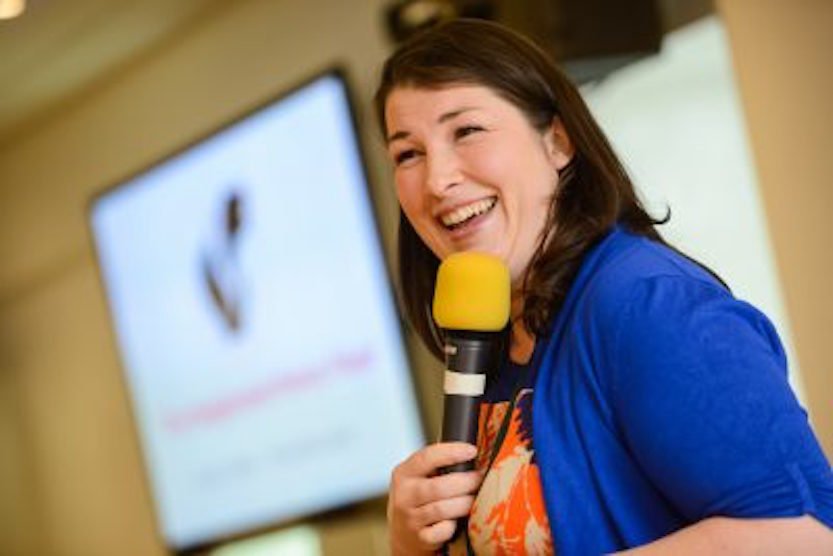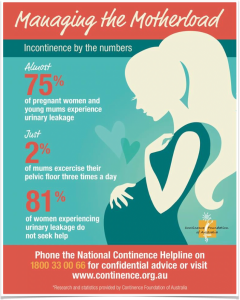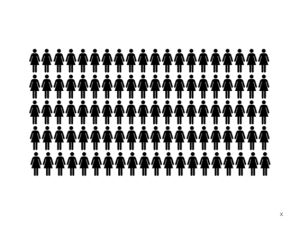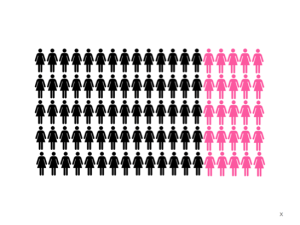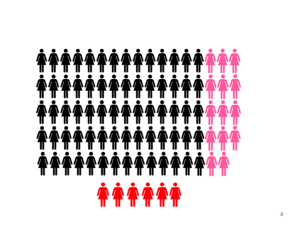In the fourth guest blog of our new series Evidence for Everyday Allied Health (#EEAHP), physiotherapist, comedian and recovered incontinent Elaine Miller, looks at how comedy has a role to play in disseminating evidence and changing health behaviours.
Allied Health Professionals have a vital role to play in rehabilitation and in times of austerity we become more significant because we are cost effective. For every pound spent on physiotherapy in managing falls, the NHS saves £1.50. We are also key to health promotion, though I think we have been under used and a bit too quiet about our achievements.
Cochrane’s work has shown that many health behaviours have solid research supporting them – yet, getting the public to comply with even simple advice remains a challenge. Even us, the people who engage with health care (well, you’re reading this blog, aren’t you?) – there are always things we know we should be doing but never quite get around to making time for. Exercise, for instance. I know fine well that I should be reducing my sitting time, but I don’t. I’ve got the education, I’ve got the motivation, I’ve got a wee app that cheers if I move more than the average slug – and, still, I spend far longer than I should on the settee.
Would it be appropriate to spend some time researching dissemination and finding effective ways of changing the health behaviour of the general public? This interests me because I’m a physiotherapist working in pelvic health. Getting people to talk about continence and sexual function is a challenge – getting them to seek help is even harder (Continence Foundation of Australia).
That matters because we know that 1:3 women leak urine and that physiotherapy is effective (NICE 2013) as a front line treatmentSomething done with the aim of improving health or relieving suffering. For example, medicines, surgery, psychological and physical therapies, diet and exercise changes.. It’s a shame that women put up with bladder symptoms because stress incontinence is largely manageable or resolvable with conservative treatment (Dumoulin 2018).
One issue with people not seeking help is that incontinence is a barrier to exercise. Diseases of inactivity kill more people than smoking does. This stuff really matters, and physiotherapy has an important role to play.
Most research in this field is conducted on subjects recruited from clinic – which is a problem as people in clinic are the unusual ones.
To demonstrate, here are all the women in the world with a pelvic floor:
Here, in pink, are the women who leak:
And, here, in red, are the women who both leak and seek help:
Those red women represent all the women who have ever spoken to their GP, seen a nurse or physiotherapist or had surgery or participated in research. I’m quite curious about the rest of them, the silently suffering majority, the ones who are putting up with it…the ones we are failing to reach.
The fact of the matter is that there are too many patients and not enough therapists. In a stretched NHS, women need to be able to identify pelvic floor problems, seek help and become self managing.
The burden of incontinence
The financial burden of NOT addressing these issues is huge. In 2012, Australia calculated that incontinence cost them $42.9 billion. That figure included not just the cost of mopping up but of managing the secondary problems like post natal depression, lost earnings and costs of moving into residential care. The UK figures mostly pertain to the cost of pads. The Australian studyAn investigation of a healthcare problem. There are different types of studies used to answer research questions, for example randomised controlled trials or observational studies. is likely to be relevant to the UK because our societies are similar, our public health burdens and economies are similar. I’d hope that physiotherapists can lobby politicians and get them to see that the figures associated with incontinence are an outrage to both the people who struggle with bowel and bladder control, and the public purse.
Humour as a health promotion tool
Perhaps it’s time to move our pelvic health promotion out of the clinics, after all that is not where most women are. Could we borrow from marketing and use humour as a health promotion tool?
Laughter is a social emotion, it has bonding qualities. Copywriters know we buy from people we like and that humour is a shortcut to forming positive relationships – which is why almost all viral advertising online is funny. We know there are physical benefits to laughter – deeper breaths, reduced stress and enhanced relaxation. Dr Patch Adams understood that and used storytelling to encourage, give comfort and manage fear. His unconventional approach led to the establishment of Clown Doctors.
Comedy is challenging to research
What is clear is that groups of people are 30 times more likely to laugh than people on their own. Laughter is infectious and has unifying effects – which could be useful in encouraging cohesion and compliance in patient groups. Logically speaking, a funny health promotion campaign should work – but how could we measure its efficacyThe extent to which an intervention (for example a drug, surgery, or exercise), produces a beneficial result under ideal conditions.?
The only established fact in humour is that it is complex, diverse and subjective in nature, so finding something that is guaranteed to make everybody laugh 100% of the time, so you can conduct a randomized controlled trialA trial in which the people taking part are randomly divided into groups. A group (the intervention group) is given the intervention being tested (for example a drug, surgery, or exercise) and compared with a group which does not receive the intervention (the control group). on it – well, that’s something of a challenge and the Holy Grail of comedy.
The possibilities for using humour in therapeutic relationships are poorly researched. Most studies used humour as a tool to compare the differences in patient engagement, or examined rehearsed as opposed to spontaneous humour. The patients’ perspective is rarely reviewed.
Laugh, don’t leak!

Given that continence and sexual dysfunctions are taboo subjects, I wondered whether, if by making them funny, it might encourage people to talk. That would lead to sharing stories, gaining empathy and perhaps being encouraged to seek help. So, I wrote a comedy show called Gusset Grippers. The aim is that the audience leaves knowing what a pelvic floor is, what it does and where to take theirs if they want to laugh, but not leak.
I’ll distribute voluntary pre-show questionnaires to measure their knowledge and quality of life. That can be compared with post-show, at six weeks and six months to see if there is any behavioural change. Of course, I’ll not be examining my jokes in this initial study. Jokes are like dissecting frogs, you’ll understand it better, but the frog dies in the process.
If you are interested in using comedy for dissemination, have a look at The Bright Club, at a university near you. I think it is worth some consideration. Health promotion requires people to be in control of themselves. Anthropologist Edward Hall said: “If you can learn the humour of a people and really control it, you know that you are also in control of nearly everything else.”
All Allied Health Professionals work with people who leak, and more of them than you realise. Allied Health Professionals have time to develop a rapport, to persuade the person to do what you know will help them, and humour can be part of that.
I’m looking forward to this series of blogs from Cochrane to broaden my horizons and celebrate what AHPs bring to the multidisciplinary team.
Join in the conversation on Twitter, where Elaine tweets @GussieGrips and you’ll find us @CochraneUK. The series hashtag is #EEAHP

Comedy, continence and collaboration by Elaine Miller is licensed under a Creative Commons Attribution-NoDerivatives 4.0 International License.
Links:
Links
Chartered Society of Physiotherapy. “Physiotherapy works: falls and frailty. Physiotherapy reduces falls, addresses frailty and restores independence”. Physiotherapy Works, Chartered Society of Physiotherapy, 9 September 2014. Web. 15 June 2016. http://www.csp.org.uk/professional-union/practice/evidence-base/physiotherapy-works/falls-and-frailty
Continence Foundation of Australia. Managing the Motherload: incontinence by the numbers [infographic]. Available from: www.continence.org.au.
National Institute for Health and Care Excellence. Urinary incontinence in women overview: stress urinary incontinence. (NICE Pathways). London: National Institute for Health and Care Excellence; 2016. Available from: http://pathways.nice.org.uk/pathways/urinary-incontinence-in-women#path=view%3A/pathways/urinary-incontinence-in-women/stress-urinary-incontinence.xml&content=view-index
National Collaborating Centre for Women’s and Children’s Health; National Institute for Health and Care Excellence (commissioner). Urinary incontinence in women: management. London: Royal College of Obstetricians and Gynaecologists; 2013. (NICE CG171). [Issued September 2013; updated January 2015]. Available from: https://www.nice.org.uk/Guidance/CG171
Dumoulin C, Cacciari LP, Hay‐Smith EJC. Pelvic floor muscle training versus no treatment, or inactive control treatments, for urinary incontinence in women. Cochrane Database of Systematic ReviewsIn systematic reviews we search for and summarize studies that answer a specific research question (e.g. is paracetamol effective and safe for treating back pain?). The studies are identified, assessed, and summarized by using a systematic and predefined approach. They inform recommendations for healthcare and research. 2018, Issue 10. Art. No.: CD005654. DOI: 10.1002/14651858.CD005654.pub4.
Woodley SJ, Lawrenson P, Boyle R, Cody JD, Mørkved S, Kernohan A, Hay-Smith EJC. Pelvic floor muscle training for preventing and treating urinary and faecal incontinence in antenatal and postnatal women. Cochrane Database of Systematic Reviews 2020, Issue 5. Art. No.: CD007471. DOI: 10.1002/14651858.CD007471.pub4.
University of Cambridge. “Lack of exercise responsible for twice as many deaths as obesity”. University of Cambridge, News, Research Impact, 14 January 2015. Web. 15 June 2016. http://www.cam.ac.uk/research/news/lack-of-exercise-responsible-for-twice-as-many-deaths-as-obesity
Ekelund U, Ward HA, Norat T, Luan J, May AM, Weiderpass E, Sharp SJ, Overvad K, Østergaard JN, Tjønneland A, Johnsen NF, Mesrine S, Fournier A, Fagherazzi G, Trichopoulou A, Lagiou P, Trichopoulos D, Li K, Kaaks R, Ferrari P, Licaj I, Jenab M, Bergmann M, Boeing H, Palli D, Sieri S, Panico S, Tumino R, Vineis P,
Peeters PH, Monnikhof E, Bueno-de-Mesquita HB, Quirós JR, Agudo A, Sánchez MJ, Huerta JM, Ardanaz E, Arriola L, Hedblad B, Wirfält E, Sund M, Johansson M, Key TJ, Travis RC, Khaw KT, Brage S, Wareham NJ, Riboli E. Physical activity and all-cause mortalitydeath across levels of overall and abdominal adiposity in European men and women: the European Prospective Investigation into Cancer and Nutrition Study (EPIC). Am J Clin Nutr 2015;101(3):613-21. doi:10.3945/ajcn.114.100065. Available from: http://www.ncbi.nlm.nih.gov/pmc/articles/PMC4340064/pdf/ajcn1013613.pdf
Weinberger MG, Gulas CS. The impact of humor in advertising: a review. Journal of Advertising 1992;21(4):35-59. Available from: http://users.auth.gr/chbouts/Humor%20Research/Humor%20in%20ad,%20a%20review.pdf.
Scott S. “Beyond a joke: how to study laughter scientifically.” The Guardian, Psychology Brain flapping, 10 July 2014. Web. 15 June 2016. https://www.theguardian.com/science/brain-flapping/2014/jul/10/joke-study-laughter-comedy-scientific
Scott SK, Lavan N, Chen S, McGettigan C. The social life of laughter. Trends Cogn Sci 2014;18(12):618-20. doi: 10.1016/j.tics.2014.09.002. Available from: http://www.ncbi.nlm.nih.gov/pmc/articles/PMC4255480/pdf/emss-61294.pdf
Clown Doctors: http://www.clowndoctors.co.uk
Bright Club: http://www.brightclub.org
Page last updated: 07 May 2020

